 About the New York School Program
About the New York School Program
The New York School concert was comprised of 23 pieces and readings from the writings of Morton Feldman, John Cage, and Earle Brown. Each of the three evenings will focused on an idea or concept that the four composers brought into the musical landscape. The three ideas are:
- Chance and Indeterminacy: A method that results in musical elements over which the composer has little control.
- Open Form: A compositional technique which supplies performers with "musical material" without specifying the exact way said material is to be arranged for performance.
- Sound as Sound: The idea that sounds can be appreciated for the sounds themselves rather than what the sounds might mean or represent.
Each of the four New York School composers had different perspectives and voiced various opinions on these three ideas. Each of them, however, integrated all three into their music at one at one point in their career. The descriptions above are very simplistic. During the concert we discussed each piece briefly and touched on many of these ideas during the course of the program.
Below is a list of pieces on each program along with descriptions and photos from the rehearsals and performances.
Cage, Fourteen (1990)
14 Piece Chamber Orchestra with Bowed Piano. Sounds are brushed into and out of existence.
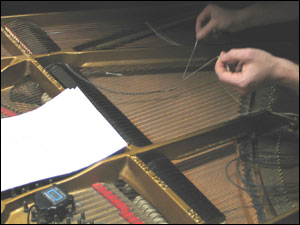
Brown, Four Systems (1954)
Written for David Tudor as a birthday present, but performable by any instrument or group of instruments. Our realization will be for Octet of piano, flute, contrabass, bassoon, electronics, clarinet, trombone, and trumpet.
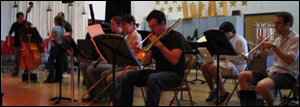
Feldman, Projection 2 (1962)
The first of Feldman's "graph notation" pieces. Scored for violin, cello, flute, trumpet, and piano, the musicians are given specific techniques, timings and dynamics, and ranges but are left to choose their exact pitches.
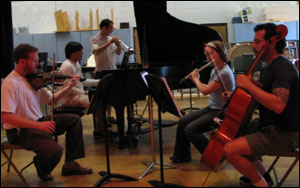
Wolff, For 1, 2 or 3 people (1964)
Performed by James Alexander, viola; Brent Fariss, contrabass; and Travis Weller, violin

Brown, December 1952
The Gates Ensemble performs this famous graphic score.
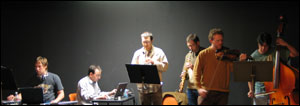
Cage, Solo for voice 17, (1970)
Brandon Young, voice; Bill Thompson, electronics. Text from remarks about the "telegraph harp" from Thoreau's "Journal". Vocal sounds electronically manipulated to sound like "singing wires."
Cage, Solo for voice 22 (1970)
Brandon Young, voice; Bill Thompson, electronics
Brown, Trio for 5 Dancers (1953)
An octet of strings and winds interprets sparse notation inspired by a dance performance.
Cage, Imaginary Landscape No. 4 (1951)
Performed by a conducted ensemble using 12 Radios, the score specifies frequencies and volumes to create an almost unpredictable sonic collage.

Wolff, Changing the System (1973)
One of Wolff's most unique pieces performed by an octet of winds, strings, percussion, and electronics.
Cage, Four (1989)
Imbroglio String Quartet performs the Arditti commission. One of Cage's "number pieces" which are some of his last works.
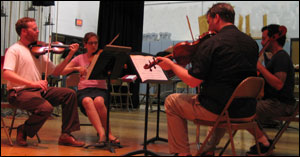
Brown, November 1952
Octet of strings, winds, and piano.
Feldman, Durations 4 (1962)
For violin, cello, and vibraphone
Brown, Available Forms 1 (1961)
18 Piece Orchestra (5 strings, 6 winds, 3 brass, harp, piano, 2 percussion) conducted by Bill Thompson
Feldman, De Kooning (1963)
For french horn, percussion, piano, violin and cello dedicated to the painter Willem De Kooning. This piece allows each sound to exhale before the next begins.
Cage, Mysterious Adventure (1945)
Michelle Schumann, prepared piano
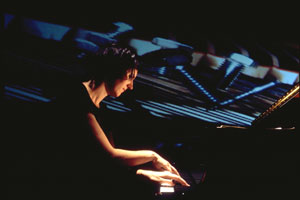
Wolff, For Violinist and Pianist (1963)
Wolff's "interaction music" performed by Travis Weller, violin and Chris Immel, piano
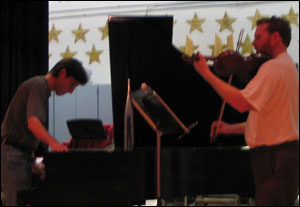
Brown, Two Pieces for Piano from "Folio" ('52-'53)
Chris Immel, piano
Cage, Living Room Music (1940)
Percussion and Voice Quartet using various articles of Furniture

Feldman, Structures for String Quartet (1951)
Feldmans earliest published string quartet. The Imbroglio String Quartet interprets this Feldman classic. Special thanks to Mary Oliver for coaching in her January masterclass.
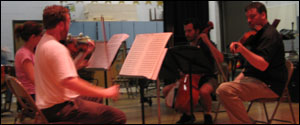
Brown, String Quartet (1965)
The Imbroglio String Quartet performs this dynamic example of Brown's open/fixed form.
Cage, A Valentine out of Season (1944)
Michelle Schumann, prepared piano
Feldman, The Viola in My Life I (1972)
The Viola in My Life I is a rarity among Feldman's work. This Viola "concerto" with flute, percussion, piano, violin, and cello features dynamic swells and melodic lines which are in contrast to the usual "flat surface" of the works of this period. Written for violist Karen Phillips, Feldman's partner at the time.

|

